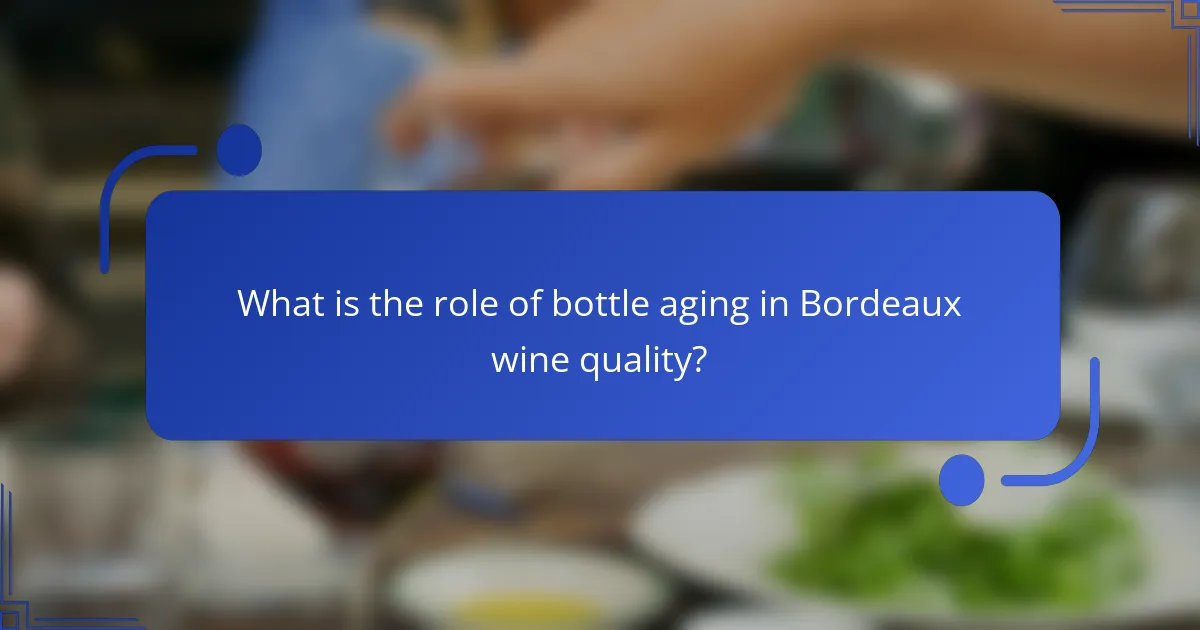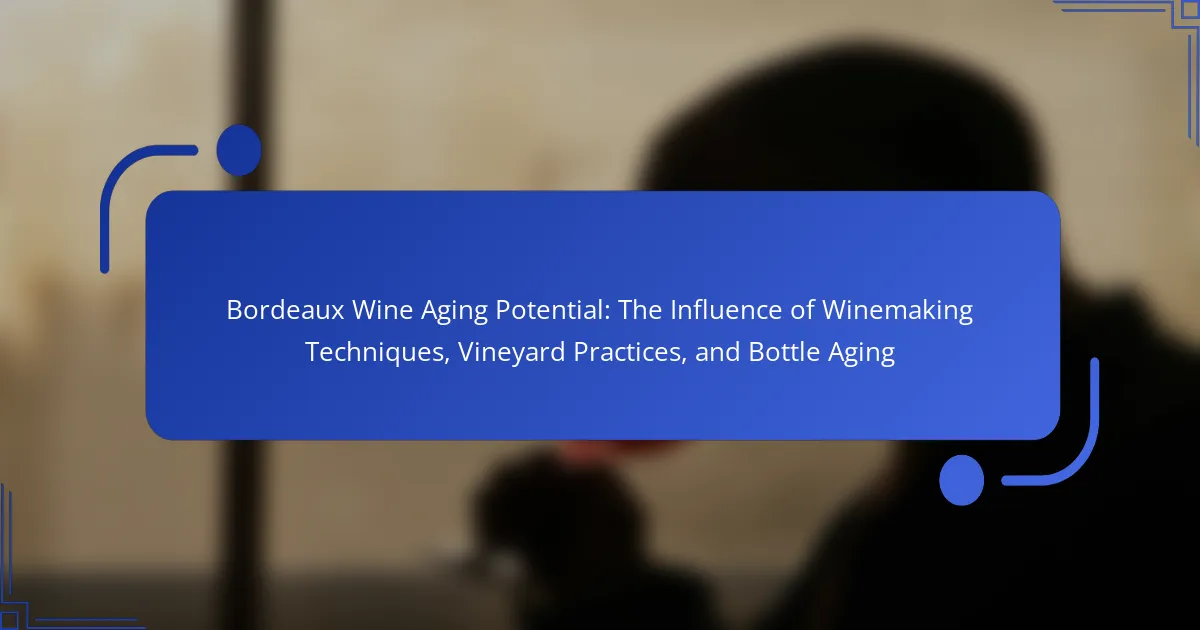
What is Bordeaux Wine Aging Potential?
Bordeaux wine aging potential refers to the ability of Bordeaux wines to improve in quality and complexity over time. This potential is influenced by factors such as grape variety, winemaking techniques, and storage conditions. Bordeaux wines, particularly those from regions like Médoc and Saint-Émilion, are often crafted with aging in mind. Many Bordeaux wines can age for a decade or more, with some prestigious labels capable of aging for several decades. The tannins and acidity in these wines contribute to their longevity. Additionally, the aging process can enhance flavors and aromas, leading to a more nuanced tasting experience. Historical evidence shows that well-stored Bordeaux wines can maintain their integrity and evolve positively over time.
How does aging affect the quality of Bordeaux wine?
Aging improves the quality of Bordeaux wine by enhancing its flavors and aromas. Over time, tannins soften, leading to a smoother mouthfeel. The wine’s acidity balances with fruit flavors, creating complexity. Aging also allows for the development of secondary and tertiary aromas, such as leather and tobacco. Bordeaux wines typically benefit from aging for 5 to 20 years, depending on the vintage and grape variety. Studies show that properly aged Bordeaux wines can achieve higher scores in blind tastings. For instance, wines aged beyond 10 years often exhibit richer profiles and greater depth. This transformation is due to chemical reactions that occur during aging, including oxidation and polymerization.
What chemical changes occur during the aging process?
Chemical changes during the aging process of Bordeaux wine include oxidation, polymerization, and esterification. Oxidation occurs as oxygen interacts with phenolic compounds, leading to the development of complex flavors and aromas. Polymerization involves the bonding of smaller phenolic compounds into larger molecules, enhancing the wine’s texture and mouthfeel. Esterification is the reaction between acids and alcohols, resulting in the formation of esters that contribute fruity and floral notes. These chemical transformations significantly influence the wine’s overall quality and aging potential, as documented in studies on wine chemistry.
How does aging influence the flavor profile of Bordeaux wine?
Aging significantly influences the flavor profile of Bordeaux wine. As Bordeaux wines age, they develop more complex flavors and aromas. Primary fruit flavors, such as blackberry and plum, gradually evolve into secondary notes like leather, tobacco, and earth. Tannins soften over time, leading to a smoother mouthfeel. The aging process also allows for the integration of oak influences, adding vanilla and spice characteristics. Oxidation occurs during aging, enhancing complexity and depth. Bordeaux wines typically require several years of aging to reach their optimal flavor profile. Research indicates that wines aged for 10 to 20 years exhibit pronounced changes in flavor and aroma, showcasing the impact of aging.
Why is understanding aging potential important for wine enthusiasts?
Understanding aging potential is crucial for wine enthusiasts because it influences the quality and flavor profile of Bordeaux wines over time. Aging allows complex flavors to develop, enhancing the wine’s character. Enthusiasts can make informed decisions on when to drink their wines for optimal enjoyment. Wines with high aging potential, like certain Bordeaux varieties, can improve significantly with age. Research indicates that tannins and acidity play key roles in a wine’s ability to age well. For instance, wines with higher tannin levels often age better and develop more nuanced flavors. Knowing the aging potential helps enthusiasts select wines that will evolve favorably. This understanding also aids in investment decisions, as certain wines appreciate in value over time.
What factors should collectors consider when evaluating aging potential?
Collectors should consider grape variety, tannin levels, acidity, and alcohol content when evaluating aging potential. Grape varieties like Cabernet Sauvignon and Merlot are known for their aging capacity. High tannin levels contribute to a wine’s structure and longevity. Acidity acts as a preservative, enhancing the wine’s ability to age gracefully. Additionally, higher alcohol content can indicate potential for aging. Historical data shows that wines with these characteristics often improve over time, confirming their aging potential.
How does aging potential impact investment in Bordeaux wines?
Aging potential significantly impacts investment in Bordeaux wines. Wines with high aging potential often appreciate in value over time. Investors seek wines that can develop complexity and depth with age. Bordeaux wines are renowned for their ability to mature gracefully. Historical auction data shows that top vintages can increase in price by over 200% after a decade. Additionally, wines from prestigious châteaux, such as Château Margaux or Château Lafite Rothschild, tend to have strong resale markets. This trend is driven by limited supply and growing global demand. Therefore, aging potential is a key factor influencing investment decisions in Bordeaux wines.

What winemaking techniques influence Bordeaux wine aging potential?
Winemaking techniques that influence Bordeaux wine aging potential include fermentation methods, oak aging, and blending practices. Fermentation methods, such as temperature control, affect the extraction of tannins and flavors. Higher temperatures can enhance color and tannin structure, which are crucial for aging. Oak aging is significant; it adds complexity and tannin, which contribute to longevity. The choice of oak type and age also impacts the wine’s aging potential. Blending practices allow winemakers to combine different grape varieties, enhancing balance and structure. These techniques collectively enhance the wine’s ability to age gracefully over time.
How do fermentation methods affect aging potential?
Fermentation methods significantly influence the aging potential of Bordeaux wines. Different fermentation techniques, such as traditional and modern methods, can alter the chemical composition of the wine. For instance, temperature-controlled fermentation can enhance the extraction of phenolic compounds. These compounds contribute to the wine’s structure and longevity. Additionally, the use of wild yeast versus cultured yeast affects flavor complexity and stability. Wines fermented with wild yeast often exhibit greater depth and can age more gracefully. Studies show that wines fermented with extended maceration retain more tannins, which are crucial for aging. Thus, the choice of fermentation method directly impacts the wine’s ability to mature and develop over time.
What role does temperature play in fermentation for aging?
Temperature significantly influences fermentation during the aging process of Bordeaux wine. It affects yeast activity, which is crucial for converting sugars into alcohol. Optimal fermentation temperatures typically range from 20°C to 30°C. At these temperatures, yeast operates efficiently, enhancing flavor development. Higher temperatures can lead to the production of unwanted compounds, affecting wine quality. Conversely, lower temperatures may slow fermentation, resulting in incomplete sugar conversion. Studies show that temperature variations can impact the wine’s aromatic profile and complexity. Therefore, managing fermentation temperature is essential for achieving desired aging potential in Bordeaux wines.
How do yeast strains impact the aging process of Bordeaux wines?
Yeast strains significantly influence the aging process of Bordeaux wines. Different yeast strains contribute distinct flavors and aromas during fermentation. These characteristics evolve as the wine ages. For instance, certain yeast strains enhance the production of esters and phenols. These compounds can lead to complex flavor profiles over time. Additionally, yeast strains affect the wine’s acidity and mouthfeel. A balanced acidity is crucial for aging potential. Research indicates that specific strains can improve the wine’s stability and longevity. This ultimately impacts the overall aging capacity of Bordeaux wines.
What influence does oak aging have on Bordeaux wines?
Oak aging significantly influences Bordeaux wines by enhancing their flavor complexity and structure. The interaction between the wine and oak barrels imparts flavors such as vanilla, spice, and toast. This aging process also contributes to the wine’s tannin integration, making it smoother and more balanced. Additionally, oak aging promotes oxidation, which can soften the wine and develop its aromatic profile over time. Research indicates that Bordeaux wines aged in oak can show improved aging potential, allowing them to evolve favorably in the bottle. The specific type of oak and the duration of aging further affect the final characteristics of the wine. For instance, French oak is commonly used for Bordeaux wines due to its fine grain and flavor contributions. Studies show that wines aged longer in oak tend to exhibit more pronounced tertiary aromas, such as leather and earthiness, which develop as the wine matures.
How does the type of oak used affect the aging characteristics?
The type of oak used significantly affects the aging characteristics of Bordeaux wine. Different oak species impart distinct flavors, aromas, and tannin structures. American oak tends to add sweeter notes like vanilla and coconut. French oak, on the other hand, contributes more subtle flavors such as spice and cedar. The level of toasting during barrel production also influences these characteristics. Heavily toasted barrels can enhance the wine’s complexity and integration of flavors. Additionally, the grain tightness of the oak affects the oxygen permeability, impacting the wine’s maturation process. Research shows that wines aged in different oak types exhibit varying profiles, altering the overall aging potential.
What is the significance of toasting levels in oak barrels?
Toasting levels in oak barrels significantly influence the flavor profile and characteristics of wine. Different toasting levels, such as light, medium, and heavy, affect the extraction of compounds from the wood. Light toasting enhances vanilla and floral notes, while medium toasting adds spice and caramel flavors. Heavy toasting can impart smoky and toasted characteristics.
The toasting process also impacts the tannin structure and mouthfeel of the wine. It can soften tannins, making the wine smoother. Additionally, the toasting levels can influence the wine’s aging potential. Research indicates that proper toasting can enhance a wine’s complexity and integration of flavors over time. Thus, winemakers carefully select toasting levels based on desired outcomes for their Bordeaux wines.

How do vineyard practices contribute to Bordeaux wine aging potential?
Vineyard practices significantly enhance Bordeaux wine’s aging potential. Proper vine management optimizes grape quality. This includes canopy management, which improves sunlight exposure and air circulation. Healthier grapes lead to better phenolic compounds. These compounds are crucial for aging. Soil management practices, such as maintaining organic matter, influence grape maturity. Well-matured grapes develop more complex flavors over time. Additionally, sustainable practices like cover cropping promote soil health. Healthy soils contribute to the overall quality of the grapes. Ultimately, these vineyard practices create a foundation for wines that age gracefully.
What are the key vineyard factors that affect aging potential?
Key vineyard factors that affect aging potential include grape variety, terroir, vine age, and vineyard management practices. Grape variety determines the inherent characteristics of the wine, including acidity and tannin levels. Terroir, which encompasses soil type, climate, and geography, influences the flavor profile and structure of the wine. Vine age contributes to the complexity of flavors; older vines typically produce more concentrated grapes. Vineyard management practices, such as canopy management and irrigation, can enhance grape quality and contribute to the wine’s aging potential. Research indicates that these factors collectively influence the sensory attributes and longevity of Bordeaux wines.
How does soil composition influence the aging characteristics of Bordeaux wines?
Soil composition significantly influences the aging characteristics of Bordeaux wines. The mineral content in the soil affects grapevine health and fruit quality. Bordeaux regions feature diverse soils, including clay, limestone, and gravel. Clay retains moisture, promoting slow ripening and complexity in wines. Limestone contributes acidity and minerality, enhancing aging potential. Gravel provides excellent drainage, encouraging deep root growth. These factors lead to wines with distinct flavor profiles and aging capabilities. Studies show that wines from well-drained soils age better, developing richer flavors over time. Soil composition is therefore crucial in determining the longevity and quality of Bordeaux wines.
What impact does vine age have on the wine’s aging potential?
Vine age significantly impacts a wine’s aging potential. Older vines typically produce grapes with more concentrated flavors and complex aromas. These characteristics enhance the wine’s structure and balance, allowing it to age more gracefully. A study published in the Journal of Wine Research found that wines from older vines exhibited greater longevity compared to those from younger vines. The research indicated that older vines have deeper root systems, accessing more nutrients and water, which contributes to the quality of the grapes. As a result, wines made from older vines often develop more nuanced flavors and improved tannin integration over time.
How does climate affect the aging potential of Bordeaux wines?
Climate significantly affects the aging potential of Bordeaux wines. Warmer temperatures can lead to earlier ripening of grapes. This results in wines with higher sugar levels and lower acidity. Higher acidity is crucial for long-term aging. Conversely, cooler climates can produce wines with balanced acidity and tannins. These factors enhance the wine’s ability to age gracefully. Additionally, climate influences the phenolic compounds in grapes. These compounds contribute to the wine’s structure and longevity. Research indicates that Bordeaux wines from cooler vintages often show better aging potential. A study by the University of Bordeaux highlights the correlation between climate conditions and wine quality over decades.
What climate conditions are optimal for producing age-worthy Bordeaux wines?
Optimal climate conditions for producing age-worthy Bordeaux wines include a temperate maritime climate. This climate features warm summers and mild winters. The region benefits from the influence of the Atlantic Ocean. This proximity moderates temperature extremes and provides consistent rainfall. Bordeaux’s clay and limestone soils retain moisture effectively. These factors contribute to balanced grape ripening. The average annual temperature ranges from 10°C to 15°C. Historical data shows that these conditions have supported high-quality vintages consistently.
How do vintage variations influence aging potential?
Vintage variations significantly influence the aging potential of Bordeaux wines. Each vintage reflects specific climatic conditions, affecting grape ripeness and acidity. Warmer years typically yield riper grapes with higher sugar levels. This can lead to wines with more robust flavors and greater aging capacity. Conversely, cooler vintages may produce wines with higher acidity and lower alcohol, which can also enhance aging potential. Historical data shows that wines from exceptional vintages, like 1982 and 2010, are often regarded as having superior aging potential. Studies indicate that a wine’s balance of tannins, acidity, and fruit concentration is crucial for longevity. Therefore, vintage variations play a critical role in determining how well a Bordeaux wine will age over time.

What is the role of bottle aging in Bordeaux wine quality?
Bottle aging significantly enhances the quality of Bordeaux wine. It allows complex flavors to develop over time. During this process, tannins soften and acidity balances. This maturation leads to a smoother mouthfeel and richer aromas. Bordeaux wines typically benefit from several years of bottle aging. Research shows that aging can improve the wine’s overall harmony and depth. For instance, studies indicate optimal aging periods for various Bordeaux varieties. These findings support the importance of bottle aging in achieving superior wine quality.
How does bottle aging differ from barrel aging?
Bottle aging and barrel aging are distinct processes in wine maturation. Bottle aging occurs after the wine is bottled, allowing it to develop complexity and integrate flavors. Barrel aging, on the other hand, takes place in oak barrels, where the wine interacts with wood and absorbs tannins, oxygen, and flavors from the barrel.
During bottle aging, the wine’s chemical reactions continue, often softening tannins and enhancing aromas. This process can last for years, depending on the wine type. Barrel aging typically lasts several months to a few years, depending on the desired flavor profile.
Barrel aging can impart specific characteristics like vanilla, spice, and toast from the wood. In contrast, bottle aging focuses on the wine’s intrinsic qualities, promoting balance and harmony. Both methods are crucial in shaping the final product, but they serve different purposes in the aging process.
What conditions are ideal for bottle aging Bordeaux wines?
Ideal conditions for bottle aging Bordeaux wines include a consistent temperature of around 55°F (13°C). This temperature helps maintain the wine’s integrity over time. Humidity levels should be between 60-75% to prevent corks from drying out. Darkness is essential; aging should occur in a dark environment to protect the wine from light exposure. Vibration should be minimized as it can disturb the sediment in the bottle. Additionally, bottles should be stored horizontally to keep the cork moist. These conditions collectively enhance the aging potential of Bordeaux wines, allowing them to develop complex flavors and aromas.
How does bottle shape and closure affect aging potential?
Bottle shape and closure significantly influence the aging potential of Bordeaux wine. The shape affects the wine’s surface area in contact with the air. A wider bottle neck can limit oxygen exposure, slowing oxidation. Conversely, a narrow neck may enhance aging by allowing controlled oxygen ingress.
Closure type also plays a critical role. Natural cork allows micro-oxygenation, which can benefit aging. In contrast, synthetic closures may prevent oxygen transfer, potentially leading to reduced complexity over time. Research shows that wines aged under cork often develop more complex flavors than those sealed with synthetic materials.
Studies indicate that bottle shape and closure can affect the wine’s evolution, with cork-sealed bottles generally yielding better aging results.
What are the best practices for storing Bordeaux wines to maximize aging potential?
The best practices for storing Bordeaux wines to maximize aging potential include maintaining a consistent temperature, controlling humidity, and minimizing light exposure. Bordeaux wines should be stored at a temperature between 50°F and 55°F (10°C to 13°C). Fluctuating temperatures can negatively impact the wine’s aging process. Humidity levels should be around 70% to prevent cork drying. Excessive light can degrade the wine, so storage should be in a dark environment. Bottles should be stored horizontally to keep the cork moist. Vibration should be minimized as it can disturb sediment. Proper ventilation is also important to prevent mold and odors. Following these practices helps preserve the wine’s quality over time.
How can temperature and humidity control enhance wine aging?
Temperature and humidity control enhances wine aging by creating an optimal environment for chemical reactions. Consistent temperatures between 50-55°F (10-13°C) promote stable aging. Fluctuations can lead to premature aging or spoilage. Proper humidity levels, ideally around 70%, prevent cork drying and oxidation. This maintains the seal and protects the wine from air exposure. Controlled conditions also help in the gradual development of flavors and aromas. Studies indicate that wines aged in stable environments show improved complexity and balance. Overall, these factors significantly influence the aging potential of Bordeaux wines.
What common mistakes should be avoided in wine storage?
Common mistakes to avoid in wine storage include improper temperature control. Wine should be stored at a consistent temperature, ideally between 50-55°F. Fluctuating temperatures can spoil wine over time. Another mistake is exposing wine to direct sunlight. UV rays can damage wine, affecting its taste and quality. Storing wine upright is also a mistake. Bottles should be kept on their sides to keep the cork moist. High humidity levels can lead to mold growth, while low humidity can dry out corks. Lastly, storing wine near strong odors can affect its flavor. Proper storage conditions are crucial for preserving wine quality.
Bordeaux wine aging potential refers to the ability of Bordeaux wines to improve in quality and complexity over time, influenced by factors such as grape variety, winemaking techniques, and storage conditions. The article explores how aging enhances flavors and aromas, the chemical changes that occur during the aging process, and the importance of understanding aging potential for wine enthusiasts and collectors. It also examines the role of vineyard practices, climate conditions, and bottle aging in determining the overall quality of Bordeaux wines. Key considerations for evaluating aging potential include grape variety, tannin levels, and winemaking techniques, which collectively contribute to a wine’s longevity and investment value.
